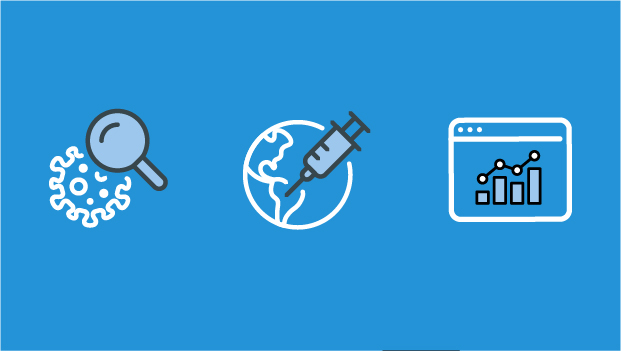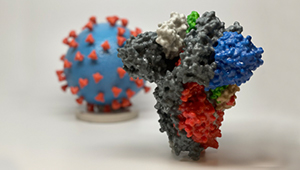The next stage in COVID-19 vaccine research

In a Viewpoint for JAMA, KPWHRI’s Dr. Mike Jackson plans ahead to meet the challenges of continuing to evaluate new vaccines
News is promising about COVID-19 vaccines, including one from Moderna with KPWHRI as a trial site. So far, efficacy seems to be higher than initially expected. While the trials progress, scientists including KPWHRI Senior Investigator Michael L. Jackson, PhD, MPH are thinking ahead about research they’ll do after the vaccine is available, as part of routine monitoring done for all vaccines.
Dr. Jackson is one of many scientists across the country who monitor vaccines for safety and effectiveness. At KPWHRI, he leads work for the U.S. Influenza Vaccine Effectiveness (US Flu VE) Network. The network uses national data, including from Kaiser Permanente Washington, to monitor the annual flu vaccine. He also co-leads KPWHRI’s Vaccine Safety Datalink (VSD) from the Centers for Disease Control and Prevention (CDC) for ongoing monitoring of all types of vaccines.
To his usual influenza vaccine surveillance, Dr. Jackson has added COVID-19 studies. VSD work, led by Dr. Lisa Jackson at KPWHRI, has included developing protocols for studying COVID-19 vaccine safety. The US Flu VE project is monitoring the influenza vaccine and preparing to include COVID-19 vaccines when they are distributed.
Studying vaccines after they are approved is standard, but COVID-19 is a new disease, creating challenges to these studies. With CDC scientists Manish Patel, MD, and Jill Ferdinands, PhD, Dr. Mike Jackson published a Journal of the American Medical Association article about post-licensure monitoring of COVID-19 vaccines. He answered questions about his current and future COVID-19-related work.
First, what’s your reaction to the news about the COVID-19 vaccines?
I was pleasantly surprised. I’m not an immunologist, but based on what we know about immunity after infection with coronaviruses, I wouldn’t have predicted efficacy in the 90% range. The big unanswered question now is how long the protective effect will last.
What are you working on now related to COVID-19?
Right now, US Flu VE is monitoring COVID-19 cases. We get data on who is seeking care, either through telehealth or at a clinic, and could have COVID-19 based on their symptoms. We call to recruit these patients for our study, and if they meet the requirements, we send them a home kit to test their COVID-19 status. From the data, we find the incidence rate, or how many people get COVID-19 over time. When a vaccine is available against SARS-CoV-2, the virus that causes the disease, we’ll study vaccine safety and effectiveness by including immunization data in our study.
Your JAMA Viewpoint notes that, as usual with any vaccine, scientists will evaluate its effectiveness once it’s available. However, some things will be different with a COVID-19 vaccine. Can you explain why?
For influenza vaccines, we determine vaccine effectiveness as the frequency of vaccination among people who have a positive test for influenza compared to the frequency among people who test negative. We call this a “test-negative” design. This design has been used to study flu vaccines all over the world for over 15 years. It’s convenient because we enroll people as they come to clinics and hospitals for respiratory illness symptoms and get tested for influenza. That means the cases and the controls — the people who test positive for influenza and those who don’t — are seeking care for similar types of illness. That reduces biases that sometimes happen in observational studies like this.
In the JAMA article, my coauthors and I write that we have to carefully consider this design for COVID-19 vaccines. One reason is that tests for SARS-CoV-2 are new and some are more accurate than others. Rapid antigen tests are convenient because they can be done in a clinic, while you wait. But they’re less accurate than the tests that are sent to a lab for a more in-depth check for SARS-CoV-2. To include people in a study for COVID-19 vaccine effectiveness, we want to use the most accurate test results.
In addition, we’re still getting data to figure out the best time during the disease course to test for SARS-CoV-2. For influenza, the time from virus exposure to symptoms is about 2 days, so our studies include people who are 7 or fewer days from illness onset. For COVID-19, the lag from virus exposure to symptoms may be longer, so people who test negative soon after they were exposed might test positive a few days later. We don’t know yet when to test people to get the most accurate results.
We also need a solid definition of who might be included in the study. From our flu work, we know that using a broad definition means we might include people with a respiratory illness that is not flu but a worsened chronic respiratory condition, and that could bias results.
What makes you feel hopeful about this work?
It’s an advantage to do this work in organizations such as Kaiser Permanente Washington, where we have a defined population of members, so we know who is potentially eligible for a study. Kaiser Permanente data are very complete, including claims data if a member gets care outside the system, which helps in doing studies like determining the COVID-19 incidence rate.
Operation Warp Speed, the national public-private partnership to accelerate the development of COVID-19 vaccines, diagnostics, and treatments, has been beneficial. The program cleared the way for vaccine trials to go quickly to phase 2/3 if they had promising phase 1 data.
We should be reassured that there’s a long-standing commitment to study vaccine safety in this country and we have the infrastructure in place to do it.
News

NIH-Moderna COVID-19 vaccine receives FDA Emergency Use Authorization
The investigational vaccine that KPWHRI’s team first tested shows an efficacy rate of about 94% as research continues.
Influenza

Flu shot Q & A: Does COVID-19 change our approach?
KPWHRI’s Michael L. Jackson, PhD, MPH, talks about influenza vaccine research in the age of the pandemic.
Research

COVID-19 pandemic research at KPWHRI
Having long tracked infectious diseases and tested vaccines, KPWHRI now focuses on the novel coronavirus.


